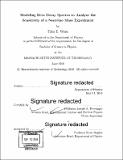Modeling beta decay spectra to analyze the sensitivity of a neutrino mass experiment
Author(s)
Weiss, Talia E
DownloadFull printable version (6.493Mb)
Other Contributors
Massachusetts Institute of Technology. Department of Physics.
Advisor
Joseph A. Formaggio.
Terms of use
Metadata
Show full item recordAbstract
The Project 8 experiment aims to measure the electron neutrino mass by obtaining and analyzing [beta] spectra from tritium decay. Using an inferential model of the experiment's anticipated data, I evaluate its projected sensitivity to certain parameters of interest. I focus on the precision and accuracy with which Project 8 can expect to resolve the [beta]-decay spectrum's endpoint in an upcoming stage of the experiment. I also present an initial prediction of Project 8's eventual expected sensitivity to the electron neutrino mass. This analysis involved generating and analyzing [beta]-decay spectral data using a model implemented in Stan, a platform for Bayesian statistical inference. The sensitivity analysis was designed to account for the anticipated distribution of results (mass and endpoint measurements) produced by the potential variation in a number of physical and experimental parameters. In addition, the method used here allows for a calibration of the consequences of inferences and decisions made in reaching those results. I find that, using one year of Project 8 Phase II data, the T2 endpoint can be resolved within a 13.7 eV window (90% C.I.) with 62% coverage (or accuracy), corresponding to a 4.1 eV posterior standard deviation. Preliminarily, using one year of Phase IV data, the electron neutrino mass can be resolved within a 0.051 eV window (90% C.I.) with 56% coverage. I also outline a way that model-based sensitivity procedures and calibration of inference can be extended to the neutrino mass hierarchy problem.
Description
Thesis: S.B., Massachusetts Institute of Technology, Department of Physics, 2018. Cataloged from PDF version of thesis. Includes bibliographical references (pages 46-47).
Date issued
2018Department
Massachusetts Institute of Technology. Department of PhysicsPublisher
Massachusetts Institute of Technology
Keywords
Physics.